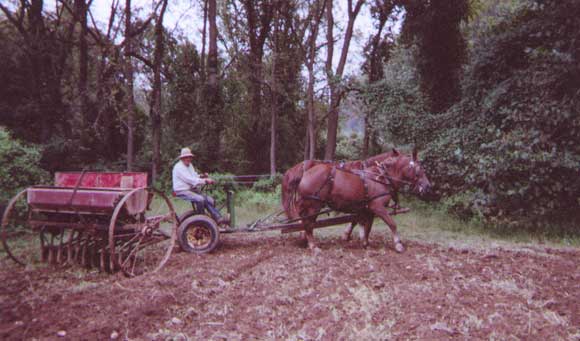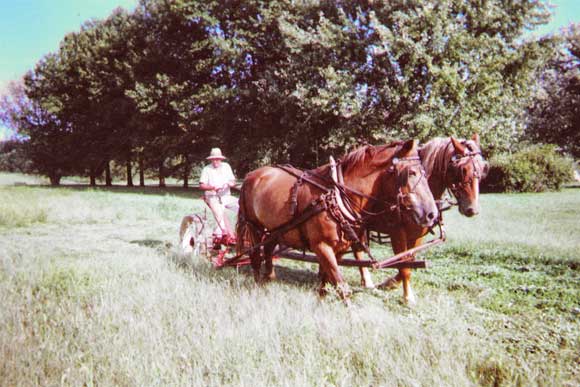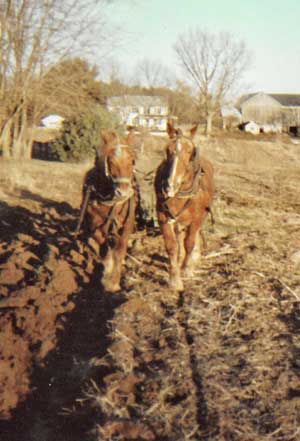Horse Powered Market Gardening Economics
Case Study: Maple Hill Farm

- Diversify production to ensure a stable income.
- Create a farm plan that my wife and I were capable of doing without outside labor.
- Create a sustainable farm by employing work horses.
For the most part, we’ve succeeded in meeting these objectives. We have five primary sources of
farm income that have given us stability — vegetable production, tree fruit, greenhouse bedding plants,
fresh egg sales, and fruit pie sales from our licensed kitchen. This diversity has helped spread out
our workload throughout the year which has enabled us to do it without depending on apprentices or
paid labor until this past year. As a concessi*-on to advancing age, this past year we had a young
lady work seven hours a week which made our life so much easier.
Lastly, I believe that our work horses have made our farm sustainable. We are able to grow all their
feed while they provide the fertility and power to work the farm. We believe it creates a sustainable
circle.

Our three horses — two Suffolks and a Belgian —each spaced approximately 10 years apart in age, provide 100% of the power to till our farm. We grow 5 acres of vegetables, ••• of an acre of peaches, and ••• acre in brambles and berries. The horses also cut and rake hay off approximately 8 acres along with planting 2 acres of speltz and less than an acre of corn.
A small tractor is used to power the baler, spray the orchard and pull our small combine. We use a tractor to bale because of our limited labor. My wife can’t drive the horses but is willing to drive a tractor pulling the baler. This enables me to stack the wagon as we bale. To use a team would force me to bale, drop it on the ground and pick up later. Using the tractor for pulling the combine also acts as a labor saver. In these cases, for us it just makes sense to rely on a tractor. Otherwise, it’s a horse-powered farm.
| Farm Products | vegetables (5 acres), bedding plants, fruit, eggs, pies |
| Markets | farmers market, gardening centers |
| Power Sources | 4 horses ($3,000), tractor |
| Gross Income | $65,283 |
| Net Income | $39,541 |
| Grain Fertilizer |
$377 |
| Veterinary | $224 |
| Baler Twine | $95 |
| Fuel | $90 |
| Seed | $89 |
| Harness Parts/Repairs | $84 |
| Minerals/Supplements | $25 |
| TOTAL | $984 |
| Vegetable Production | 117.5 |
| Hay/Grain | 50 |
| Farmstead Maintenance | 2.75 |
| Harnessing | 58.5 |
| TOTAL | 229 |
| Daily Chores | 182 |
| Clean Stalls/Dry Lot | 16.25 |
| Feed Production (non teamster) | 22 |
| Miscellaneous | 3 |
| TOTAL | 223 |
From October to mid-May we stable our horses primarily in straight tie stalls. We have very limited pasture, approximately one acre, but we turn the horses out daily in a small board fenced paddock. During the summer months, the horses spend their time
in this paddock as I simply don’t have the time to handle the manure that would collect in their stalls. They do
come in to their stalls every morning and night for their daily grain. We manage our pasture by limiting the
time we allow the horses to graze it. Maybe two to four hours a day as long as it’s growing and not getting
overgrazed. A gate leads directly from the paddock to the pasture so we don’t lead the horses anywhere. Our
paddock is only maybe 20 feet from the barn door so we simply open that gate and the horses walk into their
stalls at feeding time.
During the October through May stabling season we park our spreader outside a side door. It sits slightly
lower than our stalls, so it’s a quick, easy task to fill the wheelbarrow and push it up the planks and dump
it over the into the spreader. Although we add straw daily to their stalls, we only cleam them out once every
week or two. We use probably 100 bales of straw a year and maybe 600 plus bales of hay. Hay is fed daily year
round because of our limited pasture. We feed ear corn and speltz daily, all grown on our farm.
You may notice that we also have no time allocated for moving temporary fencing — we don’t use it. We live
in a suburban area with housing developments sprouting all along our road. We have to have absolute escape-proof
fencing to prevent potential liability. An animal getting loose in our neighborhood could cause untold amount of
damage — if not causing a dreaded accident. So we have a woven wire fence around our pasture. This past spring
we replaced the original we put up when we moved here, at a cost of approximately $1200. We also replaced our
small paddock board fence at another cost of $600. These represent long term — 30 years plus — expenses that
give us peace of mind.

With the age spacing between our horses we have both the benefit of the quiet, slow, dependable character
that an older horse gives while also benefiting from the strength and eagerness found in a younger animal. We
employ both of these characteristics in the different jobs on the farm. However, not everything goes as planned
when you suddenly lose a horse. Unfortunately, if you have horses for a length of time you will face that situation.
For us, it most recently occurred two years ago when one of our Suffolk horses suddenly stopped eating. After
visits from our local vet, we had to decide just how much money we wanted to spend looking for the cause. As
uncaring as it may sound, we just weren’t in the position to empty the bank account investigating every potential
cause. We had to draw a line as to how much money we could put into vet bills, give the horse every possible
chance to recover, and then move on. That’s also part of horse farming.
As I alluded to earlier, one of our goals was to spread the workload as evenly as possible throughout the year.
Keeping your horses working throughout the year will make a big difference in their attitude and temperament.
Obviously, there are tasks that are seasonable but we’ve been able to find work for them even in winter except
when snow is too deep or it’s simply bitter cold. For us, that’s spreading manure or compost. By winter, the
manure from our 350 bird laying flock and the cow pens is getting deep. Additionally, in our area we have access
to free mushroom compost. As long as the weather is fit — we like to spread. We also like to plow in early winter
for early spring vegetables. Keeping your horses working consistently makes for better horses and teamsters.
Unlike most produce farmers, we also grow hay and grain for our livestock. Obviously, this can result in quite a
heavy workload in the summer. I do this mostly because I really enjoy growing hay and grain. Diversity is beautiful
on the farm. To minimize the summer workload we do a couple of things. First, our growing and marketing season is
long. We start selling our first bedding plants in late march and we’re still at market at Thanksgiving. By having
such a long cash flow season we’re not compelled to push to make all our money in a relatively short time. We can
space our vegetable growing over a longer period. Additionally, we grow mostly timothy and clover mix which only
requires two cuttings versus the four or five cuttings neighbors are taking off their alfalfa. We also only cut
maybe an acre of hay at one time. It’s an amount I can handle and work into our vegetable production. First
cutting hay may take me six weeks depending on the weather. Now the downside is that not all my hay is quality.
Some gets a little old before I get to it. But as long as it gets done before we start speltz harvest in July
we’re satisfied. Corn doesn’t get picked until late fall which easily fits in.
| 2 Forecarts (homemade) | $800 |
| International 10-hole grain drill | $100 |
| International potato harvester | $600 |
| JD corn planter w/plateless seed hopper | $400 |
| Pioneer sulky plow | $450 |
| Cultipacker | $75 |
| 2 disc harrows | $900 |
| Sprint-tooth/roller combination harrow | $375 |
| International No. 9 trailer gear mower | $1,400 |
| New Idea side-delivery rake | $150 |
| 3 farm wagons | $700 |
| JD 12-A combine with JD Power Unit | $1,200 |
| Potato plow | $150 |
| Walking cultivator | $125 |
| One-row riding cultivator | $250 |
| Bean orchard sprayer with engine | $800 |
| Stone boat (homemade) | $50) |
| Scraper blade | $150 |
| New Idea 14-A manure spreader | $1,200 |
| New Holland 270 hay baler | $2,500 |
| TOTAL | $10,225* |
| *Equipment costs do not include the expense of hauling nad restoring implements, replacement parts, tongues, eveners, neck yokes etc. |
In conclusion, by recording my time it brought into perspective the actual time I do spend with my horses. The actual hours spent growing hay and grain for my horses reinforced my belief that it is financially viable. Cost containment for us has been as important as sales growth. My only disappointment from this venture had been the time I spent harnessing which proved to be greater than I would have thought and, unfortunately, is my least productive time.
I would strongly encourage all of you to do this exercise. It will create an awareness of just how much you’re using your horses and what it’s costing you. It will probably encourage you to look for more ways to integrate your horses into your farming system. You’ll find if you’re willing to commit to using horses on a regular basis, you’ll see that they are capable of doing most farm tasks. For me, I’ve come away with two lasting impressions: First — I feel my horses are very efficient in the amount of work I accomplish with them in a relatively small amount of time.
Second — when you review my time spent caring for the horses versus the hours that my horses actually worked it looks very inefficient. We don’t feel this way at all. For this particular study we need to count the time spent feeding and caring for our horses, which I understand. Yet to us, and most all teamsters, this does not constitute “work.” This makes life worth living. As I’m getting older now I dread the approaching time when I will no longer be out there feeding and caring for my horses. That’s how we enjoy life.
![]()
Paul and Carol Hauser operate Maple Hill Farm in Lincoln University, Penn.
This article appeared in the April/May 2015 issue of Rural Heritage magazine.
